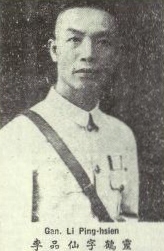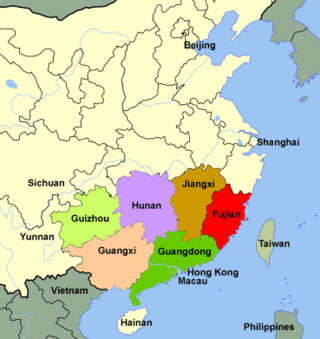
The Northern Expedition was a military campaign launched by the National Revolutionary Army (NRA) of the Kuomintang (KMT) against the Beiyang government and other regional warlords in 1926. The purpose of the campaign was to reunify China, which had become fragmented in the aftermath of the 1911 Revolution. The expedition was led by Generalissimo Chiang Kai-shek, and was divided into two phases. The first phase ended in a 1927 political split between two factions of the KMT: the right-leaning Nanjing faction, led by Chiang, and the left-leaning faction in Wuhan, led by Wang Jingwei. The split was partially motivated by Chiang's Shanghai Massacre of Communists within the KMT, which marked the end of the First United Front. In an effort to mend this schism, Chiang Kai-shek stepped down as the commander of the NRA in August 1927, and went into exile in Japan.

Xue Yue was a Chinese Nationalist military general, nicknamed the "Patton of Asia" by Claire Lee Chennault of the Flying Tigers.

The Warlord Era was the period in the history of the Republic of China between 1916 and 1928, when control of the country was divided between former military cliques of the Beiyang Army and other regional factions. It began after the death of Yuan Shikai, the de facto dictator of China after the Xinhai Revolution had overthrown the Qing dynasty and established the Republic of China in 1912. Yuan's death on 6 June 1916 created a power vacuum which was filled by military strongmen and widespread violence, chaos, and oppression. The Nationalist Kuomintang (KMT) government of Sun Yat-sen, based in Guangzhou, began to contest Yuan's Beiyang government based in Beijing for recognition as the legitimate government of China.

Zhang Fakui was a Chinese Nationalist general who fought against northern warlords, the Imperial Japanese Army and Chinese Communist forces in his military career. He served as commander-in-chief of the 8th Army Group and commander-in-chief of NRA ground force before retiring in Hong Kong in 1949.

The Central Plains War was a series of military campaigns in 1929 and 1930 that constituted a Chinese civil war between the Nationalist Kuomintang government in Nanjing led by Generalissimo Chiang Kai-shek and several regional military commanders and warlords who were former allies of Chiang.
The Yunnan clique was one of several mutually hostile cliques that split from the Beiyang Government in the Republic of China's warlord era. It was named for Yunnan Province.
The Constitutional Protection Movement was a series of movements led by Sun Yat-sen to resist the Beiyang government between 1917 and 1922, in which Sun established another government in Guangzhou as a result. It was known as the Fourth Revolution by the Kuomintang. The constitution that it intended to protect was the Provisional Constitution of the Republic of China. The first movement lasted from 1917 to 1920; the second from 1921 to 1922. An attempted third movement, begun in 1923, ultimately became the genesis for the Northern Expedition in 1926.
The Guangdong–Guangxi War, or the 1st and 2nd Yue-Gui Wars, occurred between the Kuomintang and the Old Guangxi Clique.

The New Guangxi clique, led by Li Zongren, Huang Shaohong, and Bai Chongxi, was a warlord clique during the Republic of China. After the founding of the Republic, Guangxi served as the base for one of the Old Guangxi clique, one of the most powerful warlord cliques of China. In the early 1920s, the Guangdong–Guangxi War saw the pro-Kuomintang New Guangxi clique replace the Old clique.

Shen Hongying or Shum Hung-ying was a Chinese general in the Old Guangxi Clique during the Republic of China (1912–1949). Shum was given the title of General Hip Wai (協威將軍) by President Li Yuanhong. Shen served as military governor of Guangdong from March 1923 to May 1924 in the Warlord Era. He was in alliance with Wu Peifu. He was defeated by Li Zongren in 1925.

Li Pinxian was a Republic of China Army general from Cangwu County, Guangxi. His career spanned the Xinhai Revolution, Warlord Era, the Second-Sino Japanese War, and the Chinese Civil War. After the loss of the mainland to the Chinese Communist Party in 1949, he left for Taiwan.
The Yunnan–Guangxi War was a war of succession fought for control of the Chinese Nationalist Party after the death of Sun Yat-sen in 1925. It was launched by the Yunnan clique against the party leadership and the New Guangxi clique.

The Red Turban Rebellion of 1854–1856 was a rebellion by members of the Tiandihui in the Guangdong province of South China.
Events from the year 1929 in China.

The Baise Uprising was a short-lived uprising organized by the Chinese Communist Party (CCP) in northwestern Guangxi around the city of Baise. It officially began on December 11, 1929, and lasted until late 1931. The uprising established the Seventh Red Army and a soviet over a number of counties in the You River valley. It drew support from a pre-existing movement of Zhuang peasants led by Wei Baqun, and focused on land redistribution in the area it controlled. After a brief but costly attempt to capture Guangxi's major cities, the soviet was suppressed and surviving soldiers made their way to Jiangxi. Today, it is most famous for the role played by Deng Xiaoping, who was the CCP Central Committee's leading representative in Guangxi during the Uprising. Deng was strongly criticized, both during the Cultural Revolution and by modern historians, for the uprising's swift defeat and his decision to abandon the retreating Seventh Red Army.

Lu Rongting, also spelled as Lu Yung-ting and Lu Jung-t'ing, was a late Qing/early Republican military and political leader from Wuming, Guangxi. Lu belonged to the Zhuang ethnic group.
The Battle of Guangzhou was an internal conflict within the National Revolutionary Army in the aftermath of Chiang Kai-shek's successes in the Northern Expedition. It occurred shortly after the Chinese Communist Party-led Guangzhou Uprising, which was crushed by Li Jishen's opponent Zhang Fakui. On December 28, 1927, Li Jishen's forces were able to capture Guangzhou, and Miao Peinan retreated to Huizhou. On December 29, 1927, local leader Li Fulin, an opponent of Li Jishen, was removed from office and replaced with Deng Yanhua.
The Battle of Nanning was fought between the invading Yunnan Army, allied to Chiang Kai-shek's faction, and the defending forces of the New Guangxi clique.
The Second Battle of Guilin was fought between the invading Hunan Army, allied to the forces of Chiang Kai-shek, and the forces of the New Guangxi clique personally commanded by Li Zongren. Li was facing a second invasion by the forces of the Yunnan Army targeted at Nanning. Li was forced to withdraw his forces from Guilin.

The Chiang-Gui War was a military conflict between the Nationalist government of Chiang Kai-shek against the warlord army of the New Guangxi clique that lasted from March until June 1929. A later conflict, the 2nd Chiang Gui-War, occurred between the two opposing factions in November and December of the same year.











